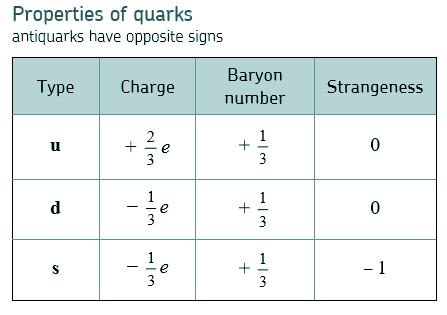|
Hadrons are made of
quarks
There are two types
of hadron that we have to know about at A Level:- the baryon and meson.
- Baryon
- 3 quarks - baryon number of 1- proton and neutron
- Anti-baryon
- 3 anti-quarks - baryon number of -1 - antiproton and antineutron.
- Meson -
a quark and an anti-quark - baryon number 0 ('cos its not a baryon!)
- kaon, pion
You only need to learn
about three quarks - the up 'u', down 'd' and strange 's' but there are others. You don't need to worry about them for the AQA
course, but it would be a good idea to look them up and give yourself
a more complete picture.
The examiner could give you baryons that contain other quarks and expect
you to classify them - if they did that they would have to give you the
quark properties in a table.... but you are expected to recall the general
types of particle classification shown above!
Each quark has characteristics
that are listed on your data sheet - you do NOT have to learn these,
you should be able to use them to work things out!

- The only two
types of meson you need to know about are the pion π
and the kaon κ.
- The kaon involves
'strangeness'. It is the only strange particle you have to
deal with in this course.
- The pion has no
strange quark.
- After the symbol
comes a charge sign - which you can work out from the data book.
|
Quark
|
Antiquark |
Meson
|
u |
̅d |
π+ |
u |
̅s |
κ+ |
u |
̅u |
πo |
d |
̅d |
πo |
d |
̅s |
κo |
d |
̅u |
π- |
s |
̅d |
κo |
s |
̅u |
κ- |
As we are limited
to u, d and s (and I have already told you that the only hadron we
have to deal with that has a strange quark is the kaon) we only have to
concern ourselves with two baryons: the proton and the neutron.
 You
know that a neutron is neutral and a proton has a charge of +1. You
know that a neutron is neutral and a proton has a charge of +1.
Using the
information in the table above (charge!) deduce what arrangement of
'u' and 'd' (three in total) makes each of the baryons we have to know
about.
proton
quark composition: ?
neutron
quark composition: ?
- The only two
types of baryon you need to know about are: the proton 'p'
and the neutron 'n'.
- Neither is 'strange'.
(The kaon (a meson) is the only strange particle you have to deal
with in this course). They are both made up of only 'u' and 'd'.
- They are each
composed of three quarks.
- You know their
charge so you can work out their composition from the data book.
What do hadrons
do?
Mesons are
involved in the strong force - they help to hold the nucleus together.
Baryons are
particles that participate in strong interactions They are composed
of three quarks, and are therefore generally more massive than mesons..
See pion and kaon
|









